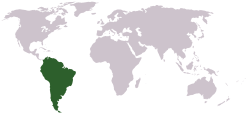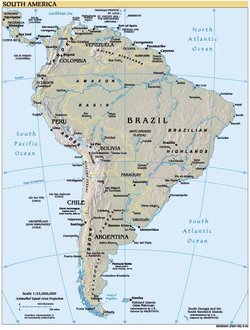South America
|
|
South_America_satellite_orthographic.jpg
South America is a sub-continent crossed by the equator, with most of its area in the Southern Hemisphere. South America is situated between the Pacific Ocean and the Atlantic Ocean. The classification of its geographic location is subject of dispute: in all non-English speaking regions of the world, America is a continent and North, Central and South America are its subcontinents. In English-speaking regions, North and South America are considered to be continents and their union is referred to as the supercontinent of America. The classification given to South America, as a subcontinent in a continent or a continent in a supercontinent, depends entirely on regional preferences. It became attached to North America only recently (geologically speaking) with the formation of the Isthmus of Panama some 3 million years ago, which resulted in the Great American Interchange. The Andes, likewise a comparatively young and seismically restless mountain range, run down the western edge of the continent; the land to the east of the Andes is largely tropical rain forest, the vast Amazon River basin.
South America ranks fourth in area and in population, after Eurasia, Africa, and North America.
It is thought to have been first inhabited by people crossing the Bering Land Bridge, now the Bering strait, though there are also suggestions of migration from the southern Pacific Ocean.
From the 1530s, the indigenous inhabitants of South America were invaded by European conquistadors, first from Spain, later from Portugal, who divided it into colonies. In the course of the 19th century, these colonies won their independence.
South america is home to many interesting species of animals including parrots, tarantulas, snakes, and mammals.
The region of South America also includes various islands, most of which belong to countries on the continent. The Caribbean territories are grouped with North America. The South American nations that border the Caribbean Sea – including Colombia, Venezuela, Guyana, Suriname, and French Guiana – are also known as Caribbean South America.
The largest country in South America by far, in both area and population, is Brazil. Regions in South America include the Andean States, the Guianas, the Southern Cone, and Eastern South America.
Political divisions of South America
(Not included in the table are South Georgia and the South Sandwich Islands which have no permanent inhabitants, only temporary visitors to research stations.)
| Name | Area (km²) | Population (2002-07-01 est.) | Population density (per km²) |
|---|---|---|---|
| Argentina | 2,766,890 | 37,812,817 | 14 |
| Bolivia | 1,098,580 | 8,445,134 | 7.7 |
| Brazil | 8,511,965 | 176,029,560 | 21 |
| Chile | 756,950 | 15,498,930 | 20 |
| Colombia | 1,138,910 | 41,008,227 | 36 |
| Ecuador | 283,560 | 13,447,494 | 47 |
| Falkland Islands (UK) | 12,173 | 2,967 | 0.24 |
| French Guiana (Fr.) | 91,000 | 182,333 | 2.0 |
| Guyana | 214,970 | 698,209 | 3.2 |
| Panama 1 | 78,200 | 3,000,463 | 37 |
| Paraguay | 406,750 | 5,884,491 | 14 |
| Peru | 1,285,220 | 27,949,639 | 22 |
| Suriname | 163,270 | 436,494 | 2.7 |
| Trinidad and Tobago 1 | 5,128 | 1,104,209 | 215 |
| Uruguay | 176,220 | 3,386,575 | 19 |
| Venezuela | 912,050 | 24,287,670 | 27 |
| Total | 17,818,508 | 355,070,540 | 19.9 |
1 These states have territory in both South and North America. See here
See also
External links
- Brazil (http://www.geographicguide.com/brazil.htm) Geographic Guide
- South America (http://www.geographicguide.com/south-america.htm)
- South America photographs (http://www.southamerica.art.pl/index_eng.php) Pictures of South America
| Continents and regions of the World |
|---|
| Africa | Antarctica | Australia | Eurasia | North America | South America Africa-Eurasia | the Americas | Asia | Europe | Oceania |


